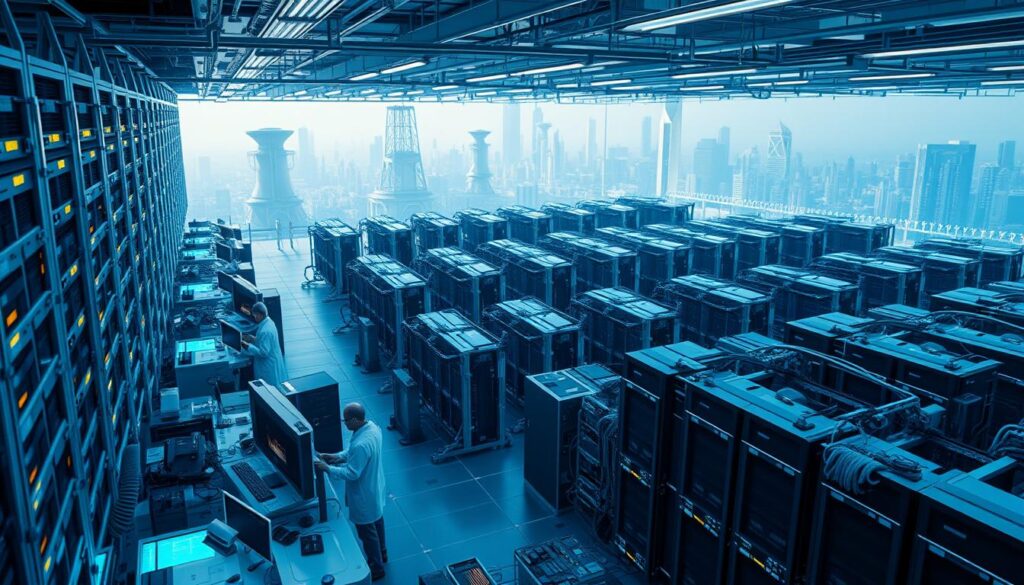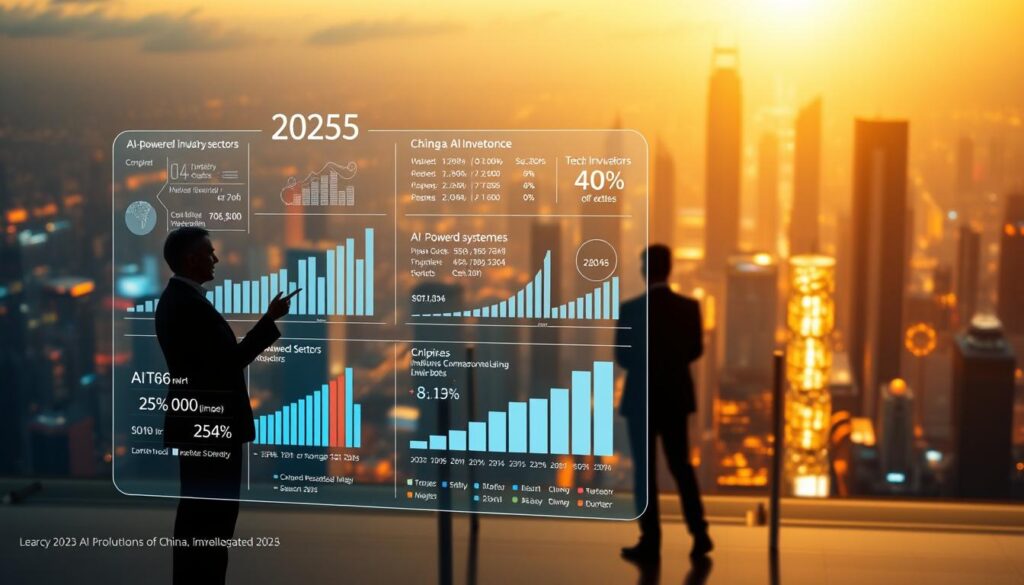As Albert Einstein once said, “The measure of intelligence is the ability to change.” This rings especially true in the rapidly evolving landscape of technological advancements. The adoption of artificial intelligence is reshaping industries globally, and China stands at the forefront of this transformation.
By 2030, the industry is projected to exceed $140 billion, with related sectors reaching a staggering $1.4 trillion in value1. Currently, over 4,300 companies contribute to this thriving economy, and the share of AI-influenced revenues in Chinese firms has more than doubled since 20181. This rapid growth is driven by significant investments and innovation, positioning China as a global leader in AI development.
However, the economic uplift may be front-loaded, with slightly smaller impacts than earlier estimates. Sectors like agriculture, manufacturing, and construction, which dominate China’s labor market, are particularly poised for transformation1. Increased capital expenditures in AI are not only influencing domestic markets but also shaping international dynamics.
This article delves into the key themes of China’s AI landscape, offering a comprehensive review of its current state and future potential. Stay tuned for an in-depth analysis of the factors driving this growth and its implications for global markets.
Key Takeaways
- China’s AI industry is projected to surpass $140 billion by 20301.
- Over 4,300 companies are actively contributing to this sector1.
- AI-influenced revenues in Chinese firms have more than doubled since 20181.
- Significant investments are driving rapid innovation and adoption.
- Sectors like agriculture and manufacturing are key areas of transformation.
Market Overview and Key Growth Trends

The landscape of technological innovation is evolving at an unprecedented pace. In this dynamic environment, the role of artificial intelligence is becoming increasingly pivotal. With a focus on investment and sector growth, the global market is witnessing transformative changes.
Key Market Statistics and Developments
The software segment accounted for a revenue share of 35.89% in 2023, highlighting its dominance in the industry2. Horizon Databook, a leading analytics platform, segments the market into hardware, software, and services, providing comprehensive insights from 2017 to 20302. This datum underscores the importance of technological diversification.
Approximately 65% of revenue is derived from competitive intelligence teams, including manufacturers and service providers2. This trend reflects the growing demand for data-driven decision-making across industries. Additionally, academic and research institutions contribute significantly, offering services at subsidized rates2.
Drivers Shaping the AI Ecosystem
Government policies play a crucial role in shaping the market. Favorable regulations and substantial investment in research and development have accelerated growth3. For instance, the implementation of AI in healthcare, finance, and manufacturing has been notably successful3.
Emerging technologies like machine learning and natural language processing are driving innovation3. Companies are increasingly adopting these tools to enhance efficiency and reduce costs. This shift is particularly evident in the manufacturing sector, where automation is revolutionizing production processes3.
For more insights into how investment strategies are shaping the future of technology, check out this detailed analysis.
Investment and Infrastructure Developments in the AI Sector

The future of technology is being shaped by massive investments and cutting-edge research. Major tech companies and model developers are increasing their capital expenditures, driving innovation across the industry. This growth is supported by advancements in semiconductors, cloud services, and infrastructure4.
Emerging technologies like machine learning and deep learning are playing a pivotal role in this transformation. These tools are not only enhancing efficiency but also reducing production costs. For instance, reduced computing power requirements are making advanced technologies more accessible5.
Capital Expenditures and Emerging Technologies
National investment strategies are fueling this progress. Governments are implementing favorable policy adjustments to support research and development. This has led to significant advancements in service models and infrastructure5.
Here are some key trends shaping the sector:
- Steady rise in capital expenditures by major tech companies4.
- Increased focus on innovative service models driven by data and research.
- Differences in investment patterns between tech and non-tech sectors5.
These developments are not only transforming the industry but also creating new opportunities for growth. As the sector evolves, the emphasis on cost-efficiency and innovation will continue to drive progress.
China’s AI Market: Statistics and Projections 2025

The rapid evolution of artificial intelligence is reshaping industries worldwide, with China leading the charge in innovation and adoption. By 2025, the market for AI agents in China is projected to grow significantly, driven by advancements in machine learning and natural language processing6.
Projections for 2025 and Beyond
The AI agents market in China was valued at USD 0.40 billion in 2024 and is estimated to reach USD 3.98 billion by 2030, with a Compound Annual Growth Rate (CAGR) of 47.1% from 2025 to 20306. This growth is fueled by increased investments in technology and infrastructure, positioning China as a global leader in AI development.
Machine learning accounted for 44.21% of the revenue share in 2024, highlighting its dominance in the sector6. Emerging technologies like deep learning are also expected to play a pivotal role in driving future advancements.
Sector-Specific Insights and Data Analysis
AI adoption is transforming key sectors such as healthcare, finance, and manufacturing. For instance, the healthcare industry is leveraging AI to improve diagnostics and patient care, while the manufacturing sector is using automation to enhance productivity7.
Here’s a comparative analysis of AI adoption across sectors:
| Sector | Key AI Applications | Projected Impact |
|---|---|---|
| Healthcare | Diagnostics, Personalized Medicine | Improved Patient Outcomes |
| Finance | Fraud Detection, Risk Management | Enhanced Security |
| Manufacturing | Automation, Predictive Maintenance | Increased Efficiency |
For more insights into how AI is shaping global markets, check out this detailed analysis.
Government Policy and Economic Impact

Government policies are playing a pivotal role in shaping the future of technological ecosystems. From trade tariffs to stimulus measures, these decisions are influencing the application of advanced technologies across industries. As economic challenges like deflation and property market pressures persist, policymakers are focusing on strategies to revitalize growth and innovation8.
Tariff Effects and Trade Policy Response
Trade policies, particularly U.S. tariffs, are having a significant impact on domestic infrastructure and economic ecosystems. These measures are reshaping global supply chains and influencing investment patterns in key sectors9. For instance, export controls on high-performance processors are affecting the computing industry, prompting nations to rethink their technological dependencies9.
In response, governments are implementing measures to bolster domestic capabilities. Programs like the “Chips and Science Act” aim to strengthen semiconductor manufacturing, ensuring long-term resilience in the face of geopolitical tensions9.
Stimulus Measures and Regulatory Challenges
To counter economic slowdowns, stimulus measures are being introduced to boost short-term demand. Consumer trade-in programs, for example, have shown effectiveness in stimulating immediate economic activity8. However, the long-term impact of these initiatives remains uncertain, requiring careful regulatory oversight.
Regulatory challenges are also emerging as governments navigate the complexities of technological advancements. Balancing innovation with economic stability is a key focus for policymakers in the coming year8. For more insights into these dynamics, explore this detailed analysis.
Labor Market and Workforce Transformation
The integration of advanced technologies is reshaping the workforce globally. Automation is driving significant changes in productivity and job roles, creating both opportunities and challenges. As industries adopt new tech, the labor market is experiencing a profound transformation10.
Automation, Productivity, and Job Disruption
AI-powered automation is boosting efficiency across diverse sectors. By streamlining repetitive tasks, businesses are achieving higher productivity levels10. However, this shift is also disrupting traditional employment structures. Jobs in writing, accounting, and programming are particularly vulnerable to replacement by generative tools11.
Despite these challenges, new roles are emerging. Demand for chatbot development and machine learning jobs is on the rise, reflecting a shift in market needs11. Companies are leveraging cloud-based solutions to support this transition, ensuring smoother integration of advanced tech into workflows10.
Socio-Economic Implications Amid Technological Change
The socio-economic impact of automation is multifaceted. While enhanced efficiency benefits the economy, job displacement poses significant challenges. Employees are increasingly apprehensive about AI, with 41% expressing concerns and requiring additional support10.
Consumer behavior is also evolving. As businesses adopt AI-driven models, the product landscape is changing. This shift is influencing both domestic and global markets, with long-term implications for economic stability11.
Here’s a comparative analysis of automation’s impact:
| Aspect | Positive Impact | Challenges |
|---|---|---|
| Productivity | Increased operational efficiency | Job displacement in traditional roles |
| Economy | Boosted growth through innovation | Uneven distribution of benefits |
| Workforce | Creation of new tech-driven roles | Skill gaps and retraining needs |
Policy and research into efficient AI models are central to mitigating these challenges. By focusing on balanced adoption, stakeholders can ensure a smoother transition for the workforce10.
Global Collaboration and Technological Innovations
The global push for technological advancement is fostering unprecedented levels of collaboration. Countries and companies are joining forces to accelerate innovation and address shared challenges. This collective effort is driving the rapid adoption of advanced technologies worldwide.
International Partnerships and AI Model Advancements
International partnerships are playing a crucial role in advancing AI technology. For instance, initiatives like the Belt and Road Initiative (BRI) are equipping local workforces with essential skills, fostering a balanced global AI landscape12. These collaborations are not only enhancing solutions but also reducing development costs, making technology more accessible.
China’s AI Capacity-Building Action Plan emphasizes digital infrastructure development, supporting data centers and high-speed internet networks12. Such efforts are streamlining efforts in AI model development, ensuring faster adoption and improved solutions.
Cost Efficiency and Breakthrough Innovations
Breakthrough innovations are reshaping the industry with a focus on cost efficiency. Companies like DeepSeek are leading the way by developing rapid and affordable solutions. These advancements are reducing the power and rate of resource consumption, making AI more sustainable.
AI-powered solutions in agriculture are optimizing irrigation and improving crop yields, directly addressing food security12. Similarly, healthcare applications are enhancing diagnostics and personalized treatments, particularly in regions with limited infrastructure12.
Here’s a comparative analysis of global AI collaboration:
| Initiative | Key Focus | Impact |
|---|---|---|
| Belt and Road Initiative | Skill Development | Balanced Global AI Landscape |
| AI Capacity-Building Plan | Infrastructure | Faster Adoption |
| DeepSeek Innovations | Cost Efficiency | Sustainable Solutions |
For more insights into how global collaboration is shaping the future of technology, explore this detailed analysis.
Conclusion
The transformative role of technology continues to shape industries globally, with significant advancements driving growth and innovation. Key findings highlight the interplay between investment, government policy, and technological developments, creating both opportunities and challenges for firms13.
For consumers and investors, these trends offer valuable insight into the evolving landscape. The finance sector, in particular, is witnessing rapid changes, with tailored solutions addressing specific needs14. However, concerns about competition and resource allocation remain critical.
To stay ahead, firms must navigate these dynamics strategically. For more detailed analysis, explore this comprehensive report. Share your thoughts and join the discussion on how these trends will shape the future.
FAQ
What are the key drivers shaping China’s artificial intelligence ecosystem?
How is the government supporting the development of AI technologies?
What are the projections for China’s AI market by 2025?
How is AI impacting the labor market in China?
What role do international partnerships play in China’s AI advancements?
Which sectors are expected to benefit most from AI adoption in China?
What challenges does China face in scaling its AI capabilities?
Source Links
- China Artificial Intelligence Market Size & Outlook, 2030
- Market Size
- AI investment trends 2025: Beyond the bubble | J.P. Morgan Asset Management
- Artificial Intelligence (AI) Infrastructure Market Size to Hit USD 499.33 Billion by 2034
- China AI Agents Market Size & Outlook, 2030
- China’s advances could boost AI’s impact on global GDP
- China Key Themes 2025: A policy-driven, half-full glass economy
- The role of policies on technology and AI for innovation and increased competitiveness in North America
- Superagency in the workplace: Empowering people to unlock AI’s full potential
- Expert Comment: How is generative AI transforming the labour market?
- China’s AI Leap 2025: Win for Both Global North and Global South
- Assessing China’s AI development and forecasting its future tech priorities
- Exploring China’s Leading AI Hubs: A Regional Analysis







